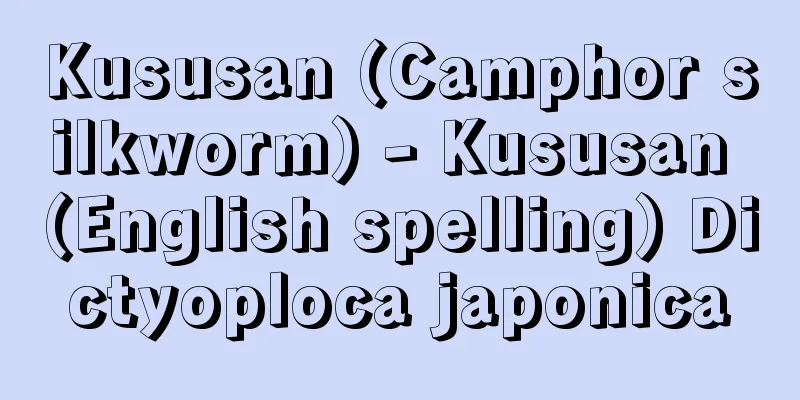Dried Foods - Dried Foods

|
Foods that have been dried by reducing the moisture content of fresh foods, either naturally in the sun or by artificial means such as hot air or freezing. Drying has a very long history. The original purpose of drying was simply to store food, but today it is often used to bring out flavors that cannot be enjoyed in raw foods, and to reduce the weight of foods by removing moisture, thereby lowering transportation costs. [Tomomi Kono] historyIn the Neolithic period, when humans lived in the mountains and fields in search of food, it is believed that they preserved food by drying it in the sun. In an era when food production was left to nature, drying preservation is thought to have been an important means of regulating food supply and demand. Food can be dried without any equipment, so no containers have been found in ruins, and there is no evidence of dried foods. However, it is known that dried meat products existed in pre-Christian Egypt and the Inca Empire, and in Japan, during the Nara period, products such as kitai, which is whole, dried bird and animal meat, and suwayari, which is fish meat that is cut into small pieces, salted, and then dried, were already in existence, which are thought to have been influenced by China. In addition to these, there were also dried seafood, dried fish, dried abalone, dried abalone, as well as dried vegetables and fruits. Additionally, frozen tofu (koya tofu), which is made by freezing tofu outdoors during the cold season and then drying it, is also an excellent dried food. [Tomomi Kono] natureFresh foods have poor preservation properties due to their high water content, but if the water content is reduced to 40% or less, the activity of enzymes in the food slows down, the growth of microorganisms is also suppressed, and the food is relatively resistant to deterioration. Dried foods take advantage of this property, but on the other hand, the oxidation caused by oxygen in the air becomes greater, which is difficult to prevent. Proteins also gradually denature, and when cooked, they often have a bad mouthfeel. Fats also change significantly due to oxidation, causing unpleasant odors, and some lipid peroxides combine with amino acids to turn yellowish brown, causing what is known as scorching. Scorching not only reduces the flavor of the food, but can also cause diarrhea and discomfort when eaten. [Tomomi Kono] kindsThere are various methods for drying food, but currently the methods listed in can be listed. Recently, research has been conducted on preventing the deterioration of food color, taste, and aroma due to drying, and new drying methods have been developed to replace natural drying. Vacuum drying is a method that minimizes the effects of air, light, and heat, which cause quality deterioration during drying. Among these, vacuum freeze drying is particularly excellent and is widely used as an ingredient in various processed foods. In addition, to make dried foods easier to rehydrate, powdered foods are processed into porous granules or dispersants are added. In addition, bleaching agents such as sulfurous acid are sometimes added to prevent discoloration during drying. For vegetables, a method such as pressure puffing has been developed to prevent the hardening of plant fibers due to freezing and drying, in which the tissue is made porous by lightly pressurizing and heating the food and then suddenly releasing the pressure. This method is mainly used for root vegetables and thick-fleshed vegetables such as carrots, potatoes, and onions. [Tomomi Kono] keepDried foods are susceptible to deterioration due to moisture absorption and air during storage, so they are stored in sealed packaging containers, vacuum-packed, or even by replacing the air in the container with nitrogen gas. The fat content in dried foods is particularly susceptible to change, so oxygen scavengers and antioxidants are sometimes used to prevent this. [Tomomi Kono] "Fundamentals and Applications of Dried Foods" by Mitsuo Kamewada, Hiromichi Hayashi, and Shigeru Tsuchida (1997, Saiwai Shobo) ©Shogakukan "> Drying methods and major dried foods [Table] Source: Shogakukan Encyclopedia Nipponica About Encyclopedia Nipponica Information | Legend |
|
生鮮食品を、天日により自然に、または温風、凍結など人工によって水分を減少させ、乾燥状態にした食品類。その歴史は非常に古い。乾燥の目的は、初めは食品の貯蔵だけであったが、今日ではそのほか、乾燥によって、生(なま)では味わえない風味を出したり、水分を除くことで重量を減らして輸送などの経費を下げるためにも行われることも多い。 [河野友美] 歴史人類が山野に食糧を求めて生活していた新石器時代には、とってきた食糧を天日乾燥して保存していたと推定される。食品の生産が自然まかせであった時代には、乾燥保存は重要な食糧需給の調節手段であったと考えられる。食品の乾燥は器具なしでできるため、遺跡から容器などが発見されないので、乾燥食品の実証資料がない。しかし紀元前のエジプトやインカ帝国に肉類の乾燥品のあったことは知られているし、日本でも、奈良時代にはすでに中国からの影響を受けたと思われる、鳥獣肉を全身まるのまま乾燥した腊(きたい)、魚肉を細かく切って塩漬けにしたのち干した楚割(すわやり)などがあった。このほか、海産物を干した、干し魚、のしあわび、干しあわびなどや、野菜、果実などを干したものもあった。 また寒中に豆腐を屋外で凍結したのち乾燥した凍り豆腐(高野豆腐)も、優れた乾燥食品の一つである。 [河野友美] 性質生鮮食品は水分を多く含むため保存性に乏しいが、水分を40%以下にすると、食品中の酵素の働きが緩やかになり、微生物の繁殖も抑えて比較的変質しにくくなる。乾燥食品はこの性質を利用したものであるが、一方、空気中の酸素による酸化作用が大きくなり、これを防ぐことがむずかしい。また、タンパク質も徐々に変性をおこして、料理した場合、口あたりの悪くなることが多い。脂肪も酸化による変化が大きく、不快臭の原因となるほか、過酸化脂質の一部はアミノ酸と結合して黄褐色を呈し、いわゆる油焼けの原因となる。油焼けをおこすと、味の低下だけでなく、食用により下痢や不快感を呈することもある。 [河野友美] 種類食品の乾燥は種々の方法があるが、現在ではのような方法をあげることができる。 最近は、乾燥による食品の色、味、香りなどの低下を防止する研究が進み、自然乾燥にかわって新しい乾燥法もできてきた。減圧乾燥は、乾燥の際に品質低下の原因になる空気、光、熱などの影響をなるべく受けないようにした方法で、そのなかでも凍結真空乾燥がとくに優れ、各種加工食品の材料として広く利用されている。また、乾燥食品をもどりやすくするためのくふうとして、粉末状のものでは、多孔質の粒状に加工するとか、分散剤のようなものを添加することも行われている。また、乾燥中の変色を防ぐため、亜硫酸などの漂白剤を添加することもある。野菜では、凍結や乾燥による植物繊維の硬化を防ぐため、軽く加圧加熱したあと急激に圧力を抜き、組織を多孔質にしたのち乾燥するプレッシャーパフなどの方法も開発され、ニンジン、ジャガイモ、タマネギなど主として根菜類や肉厚な野菜類に用いられる。 [河野友美] 保存乾燥食品は、貯蔵中の吸湿や空気による変質が大きいので、密閉された包装容器や、真空包装などの方法、さらには、容器中の空気を窒素ガスに置き換えたりする方法などもとられている。乾燥食品中とくに変化の激しいのは脂肪分であり、これを防止するため脱酸素剤や酸化防止剤が使用されることもある。 [河野友美] 『亀和田光男・林弘通・土田茂著『乾燥食品の基礎と応用』(1997・幸書房)』 ©Shogakukan"> 乾燥法とおもな乾燥食品〔表〕 出典 小学館 日本大百科全書(ニッポニカ)日本大百科全書(ニッポニカ)について 情報 | 凡例 |
>>: Desiccant - Kansouzai (English spelling) desiccant
Recommend
Onga River Plain
...It includes small basins such as Iizuka (Kaho)...
Unicorn (English spelling)
Also called the unicorn. A legendary animal with a...
Okinawa catfish - Okinawa catfish
...It is widely distributed in central and southe...
Akimado firefly - Akimado firefly
...The black-spotted firefly Pyrocoelia fumosa an...
Mount Iya
The name given to the mountainous area in the Iya ...
Return
…It was originally implemented as one of the poli...
hennin
…In Western Europe, under the influence of Byzant...
Teppei Kataoka
Novelist. Born in Okayama Prefecture. Active as a...
Tropical Bird - Tropical Bird
A general term for birds in the Tropicidae family....
Heigawa River
This river originates at Mt. Kabutomyojindake (1,...
Homo (English spelling)
…After World War II, he moved to the University o...
Sodo - Narabi-do
This is an ancient building in which two halls are...
Tomomi Narita
Politician. Born in Kagawa Prefecture. After grad...
Stove surroundings - Around the stove
...After sending off the dead on the evening of J...
Rugby School - Rugby Ko
Rugby is a representative public school in the UK,...









